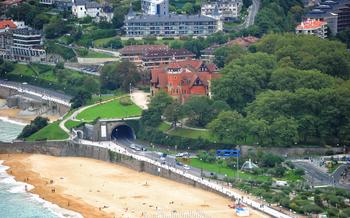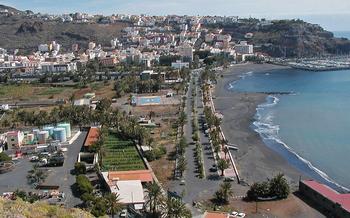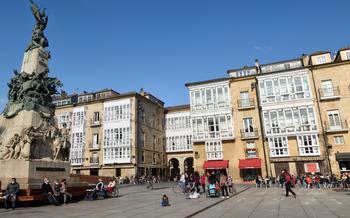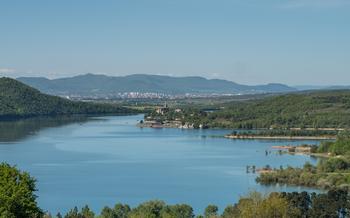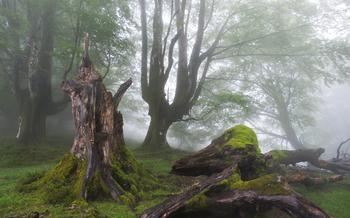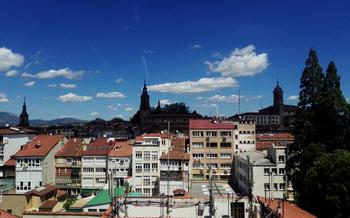
Dolmen de Sorginetxe (megalithic monument)
- The Dolmen de Sorginetxe: A Historical Masterpiece
- Unveiling the Neolithic Era
- Exploring the Dolmen's Architecture
- A Journey Through Time: The Dolmen's History
- The Enigmatic Purpose of the Dolmen
- Unraveling the Dolmen's Secrets: Archaeological Findings
- The Dolmen's Place in Basque Culture
- The Dolmen's Connection to Nature
- The Dolmen and Modern-Day Rituals
- The Dolmen's Contribution to Megalithic Studies
- Tips for Visiting the Dolmen de Sorginetxe
- Local Cuisine and Dining Options
- Accommodations and Lodging Options
- Insider Tip: Hidden Gem Nearby
The Dolmen de Sorginetxe: A Historical Masterpiece
The Dolmen de Sorginetxe stands as a testament to the ingenuity and craftsmanship of the Neolithic era. Classified as a megalithic monument, it is a remarkable example of the architectural achievements of prehistoric societies. Constructed using massive stones, the dolmen consists of a large capstone resting on several supporting stones, forming a chamber-like structure. Its historical significance lies in its ability to transport visitors back in time, enabling them to connect with the ancient people who built it and glimpse into their lives.
Located in the Basque Country, Spain, the Dolmen de Sorginetxe is easily accessible by car and is open to the public throughout the year. Visitors can explore the site at their leisure, marveling at the impressive size and intricate construction of the dolmen. It is a must-see destination for those interested in ancient history, archaeology, and the mysteries of the Neolithic era.
The architectural features of the Dolmen de Sorginetxe are particularly intriguing. The massive capstone, weighing several tons, is supported by carefully positioned vertical stones, creating a stable and durable structure. The dolmen's chamber, once likely used for burial or ritual purposes, exudes a sense of solemnity and reverence.
Local legends and myths surround the Dolmen de Sorginetxe, adding to its allure and mystique. Some believe it was built by giants or supernatural beings, while others claim it possesses magical properties. These stories, passed down through generations, reflect the deep connection between the Basque people and this ancient monument.
Unveiling the Neolithic Era
The Dolmen de Sorginetxe stands as a testament to the Neolithic era, a period of significant transformation and innovation in human history. During this time, people began to settle into agricultural communities, leading to the development of new technologies, social structures, and rituals. The dolmen, with its intricate construction and alignment, offers a glimpse into the lives of these early inhabitants.
By carefully observing the dolmen's features, we can piece together the daily lives, rituals, and beliefs of the Neolithic people. The dolmen's chamber may have served as a gathering place for communal activities, a site for religious ceremonies, or a burial ground for the community's deceased. The alignment of the dolmen with the sun's position during the solstices and equinoxes suggests that it may have had astronomical significance, marking important seasonal changes or celestial events.
The dolmen's construction itself speaks volumes about the ingenuity and engineering prowess of the Neolithic people. Despite having limited tools and knowledge, they managed to transport and erect massive stones, creating a structure that has stood the test of time. The dolmen's stability and durability are a testament to the skill and perseverance of these ancient builders.
Exploring the Dolmen's Architecture
The Dolmen de Sorginetxe showcases impressive architectural elements that reflect the ingenuity and capabilities of the Neolithic builders. The most striking feature is its massive capstone, weighing approximately 10 tons. Supported by several upright stones, it forms a chamber that once served as a burial site. Visitors can closely observe the capstone's intricate carvings, which may have held symbolic or religious significance. The supporting stones, known as orthostats, exhibit careful selection and placement, demonstrating the builders' understanding of stability and weight distribution. Additionally, the dolmen's orientation suggests that it may have been aligned with astronomical events, hinting at the builders' knowledge of celestial movements. By studying these architectural features, we gain insights into the engineering prowess and cultural beliefs of the Neolithic people who constructed this remarkable monument.
A Journey Through Time: The Dolmen's History
Description
The Dolmen de Sorginetxe has stood the test of time, witnessing the rise and fall of civilizations. Its history can be traced back to the Neolithic era, around 3000 BC, when it was constructed by the region's early inhabitants. Over the centuries, the dolmen has undergone various transformations and influences. During the Bronze Age, it was likely repurposed for burial purposes, as evidenced by the discovery of human remains and artifacts within its chamber. In the Middle Ages, the dolmen became associated with local folklore and mythology, inspiring legends and stories that have been passed down through generations.
Practical
Visitors to the Dolmen de Sorginetxe can explore the different phases of its existence through guided tours and educational materials provided on-site. The dolmen's unique features, such as its intricate carvings and the positioning of its stones, offer clues to its various uses and modifications throughout history.
Theoretical
The Dolmen de Sorginetxe is a valuable source of information for archaeologists and historians, providing insights into the lives and beliefs of prehistoric societies. Its preservation and study contribute to our understanding of the development of human culture and the role of megalithic monuments in ancient civilizations.
Anecdotes
Local legends often intertwine with the history of the Dolmen de Sorginetxe. One tale speaks of a giantess named Sorginetxe who built the dolmen as a shelter for herself and her sheep. Another legend tells of a hidden treasure buried beneath the dolmen, guarded by a fierce dragon. These stories add a touch of mystery and enchantment to the dolmen's already captivating history.
The Enigmatic Purpose of the Dolmen
The Dolmen de Sorginetxe has sparked numerous debates and theories regarding its intended purpose. While its primary function as a burial chamber is widely accepted, other interpretations suggest it may have served various roles in Neolithic society. Some scholars propose that the dolmen's alignment with the sunrise during the summer solstice indicates its use as an astronomical observatory, allowing ancient people to track seasonal changes and celestial events. Others have suggested that the dolmen's unique acoustics and enclosed space may have facilitated religious rituals or ceremonies, creating an immersive and sacred environment for spiritual practices.
Identifying and interpreting the features that support or contradict each theory requires careful observation and analysis. The dolmen's orientation, internal chamber, and surrounding landscape provide clues to its potential astronomical significance. Conversely, the presence of human remains, grave goods, and ritualistic markings suggests its primary use as a burial site. Understanding the dolmen's intended purpose sheds light on the beliefs, practices, and social structures of the Neolithic people who constructed it.
Anecdotes
During my visit to the Dolmen de Sorginetxe, I couldn't help but wonder about the rituals and ceremonies that might have taken place within its ancient chamber. I imagined Neolithic shamans or priests using the dolmen's acoustics to create a trance-like state, or perhaps using the sunlight's alignment during solstices to mark significant events in the community's calendar. These thoughts transported me back in time, allowing me to glimpse into the lives and beliefs of the people who built this enigmatic monument.
Unraveling the Dolmen's Secrets: Archaeological Findings
The Dolmen de Sorginetxe has been the subject of extensive archaeological excavations and research, revealing a wealth of artifacts and information that shed light on the lives and practices of the Neolithic people who built it. During excavations conducted in the 19th and 20th centuries, archaeologists uncovered a variety of artifacts, including stone tools, pottery fragments, and human remains. These findings have provided valuable insights into the daily life, rituals, and beliefs of the Neolithic inhabitants of the region.
One of the most significant discoveries was the presence of human remains within the dolmen's chamber. These remains suggest that the dolmen was used as a burial chamber, a common practice among Neolithic societies. The presence of grave goods, such as pottery vessels and stone tools, further supports this theory. By studying the human remains and associated artifacts, archaeologists have gained valuable information about the physical characteristics, health, and funerary practices of the Neolithic people.
The archaeological excavations have also revealed evidence of the dolmen's use as a ritual or ceremonial site. The presence of hearths, burnt animal bones, and other ritual objects suggests that the dolmen was a place of gathering for religious or spiritual practices. These findings provide a glimpse into the spiritual beliefs and rituals of the Neolithic communities who frequented the site.
The archaeological research conducted at the Dolmen de Sorginetxe has significantly contributed to our understanding of Neolithic culture and society in the Basque region. The artifacts and evidence uncovered at the site have helped to reconstruct the lives and practices of these ancient people, shedding light on their burial customs, rituals, and beliefs.
The Dolmen's Place in Basque Culture
The Dolmen de Sorginetxe is deeply embedded in the cultural fabric of the Basque people. Local legends and traditions weave intricate tales around this ancient monument, adding layers of meaning to its historical significance. One popular legend speaks of a mythical creature known as the "sorgin," or witch, who is said to have used the dolmen as a meeting place for her coven. Another legend tells of a hidden treasure buried beneath the dolmen, guarded by the spirits of ancient Basque warriors.
During the annual summer solstice, the dolmen becomes a focal point for traditional Basque festivals and celebrations. Locals gather around the monument to pay homage to their ancestors, dance to the rhythm of traditional music, and share stories and legends that have been passed down through generations. These festivals are a testament to the enduring connection between the Basque people and their prehistoric heritage.
The dolmen's cultural significance extends beyond local legends and festivals. It serves as a symbol of Basque identity, resilience, and connection to the land. By preserving and celebrating this ancient monument, the Basque people honor their rich cultural heritage and strengthen the bonds that unite their community.
The Dolmen's Connection to Nature
The Dolmen de Sorginetxe stands in harmony with its natural surroundings, inviting visitors to explore the relationship between this ancient monument and the environment. Its orientation and location suggest a connection to astronomical phenomena. During the summer solstice, the first rays of sunlight illuminate the interior of the chamber, creating a mesmerizing spectacle that draws visitors from around the world. The dolmen appears to align with the rising sun on this significant day, demonstrating the knowledge and precision of the Neolithic builders.
Beyond its solar alignment, the dolmen's connection to nature is evident in its positioning amidst a diverse ecosystem. The surrounding landscape boasts a variety of flora and fauna, creating a rich tapestry of life that complements the historical significance of the site. Visitors can stroll through the nearby forests, teeming with diverse plant and animal species, and admire the natural beauty that envelops the dolmen.
Observing the dolmen within the context of its natural surroundings offers a deeper appreciation for the ingenuity and foresight of the Neolithic people. Their understanding of celestial movements and the integration of the dolmen into the landscape showcase their deep connection to the natural world. Visitors are encouraged to take a moment to appreciate the harmony between the dolmen and its environment, contemplating the symbiotic relationship that existed between humans and nature in ancient times.
The Dolmen and Modern-Day Rituals
The Dolmen de Sorginetxe is not merely a relic of the past; it continues to hold significance in contemporary Basque culture. While its original purpose may be shrouded in mystery, the dolmen has become a site for modern-day rituals and spiritual practices.
For many, the dolmen serves as a place of contemplation, reflection, and connection with the natural world. Visitors are drawn to its ancient energy and find solace in its peaceful atmosphere. Some choose to meditate or perform yoga among its megalithic stones, seeking a deeper connection to the earth and the cosmos.
The dolmen is also a venue for more formal rituals and ceremonies. Basque cultural associations and spiritual groups hold seasonal gatherings and celebrations at the site, honoring ancient traditions and paying homage to the ancestors. These rituals often involve music, dance, storytelling, and the sharing of food and drink.
Visitors are welcome to observe these rituals and ceremonies, provided they are respectful and mindful of the participants' privacy. It is important to remember that the dolmen is a sacred space for many, and visitors should behave accordingly.
Participating in or simply observing these rituals can be a deeply moving and enriching experience, offering a glimpse into the rich cultural heritage of the Basque people. It is a reminder that the dolmen is not just a historical monument but a living, breathing part of the community.
The Dolmen's Contribution to Megalithic Studies
The Dolmen de Sorginetxe holds immense significance in the field of megalithic studies, contributing to our understanding of prehistoric cultures worldwide. As a well-preserved example of a dolmen, it provides valuable insights into the construction techniques, architectural features, and cultural practices of ancient societies. By studying the dolmen's orientation, chamber design, and surrounding environment, researchers can gain insights into the astronomical knowledge, religious beliefs, and social structures of the Neolithic people.
Moreover, the Dolmen de Sorginetxe serves as a reminder of the interconnectedness of ancient cultures. Comparisons between the dolmen and similar megalithic monuments found in other parts of Europe and beyond have shed light on the cultural exchanges and interactions that took place during the Neolithic period. This cross-cultural analysis helps researchers piece together the puzzle of prehistoric societies and their migrations, revealing patterns of cultural diffusion and the spread of ideas and technologies across vast distances.
By studying the Dolmen de Sorginetxe, researchers can gain valuable insights into the lives and beliefs of our ancestors, bridging the gap between the present and the distant past. It is through the study of such megalithic monuments that we can unlock the secrets of prehistoric societies and gain a deeper appreciation for their ingenuity, resilience, and connection to the natural world.
Tips for Visiting the Dolmen de Sorginetxe
Planning a visit to the Dolmen de Sorginetxe is an enriching experience that offers a glimpse into the past. Here are some practical tips to ensure a smooth and enjoyable visit:
-
Transportation: The dolmen is easily accessible by car, and there is ample parking space near the site. If traveling by public transportation, take the bus from Vitoria-Gasteiz to the village of Argómaniz and walk the remaining distance to the dolmen.
-
Visiting Hours: The Dolmen de Sorginetxe is open to visitors throughout the year, but the best time to visit is during the spring or fall, when the weather is pleasant and the surrounding landscape is vibrant.
-
Guided Tours: To enhance your visit, consider booking a guided tour led by local experts. These tours provide insightful information about the dolmen's history, architecture, and significance, allowing you to delve deeper into its mysteries.
-
Accessibility: The dolmen is situated in a natural setting, and the terrain can be uneven. Wear comfortable shoes and be prepared for a short walk from the parking area to the dolmen.
-
Responsible Tourism: Remember that the Dolmen de Sorginetxe is a historical monument and a symbol of cultural heritage. Respect the site by refraining from climbing on the stones or damaging the surrounding environment.
-
Discover More: Combine your visit to the Dolmen de Sorginetxe with other nearby attractions such as the town of Vitoria-Gasteiz, the Gorbea Natural Park, or the Añana Salt Valley. These destinations offer unique experiences and insights into the region's rich history and culture.
Local Cuisine and Dining Options
Indulge in a culinary journey through the Basque Country's rich flavors and traditions near the Dolmen de Sorginetxe. From traditional Basque cuisine to modern interpretations, the region offers a diverse range of dining experiences. Savor the region's signature dishes, such as pintxos (small tapas-like snacks), succulent grilled meats, and fresh seafood. Enjoy the vibrant atmosphere of local markets, where you can sample local delicacies and interact with friendly vendors. Whether you prefer a cozy family-run restaurant or a Michelin-starred establishment, there's something to satisfy every palate and budget. Don't miss the opportunity to experience the Basque Country's culinary delights, which perfectly complement the historical and cultural significance of the Dolmen de Sorginetxe.
Accommodations and Lodging Options
When planning your stay near the Dolmen de Sorginetxe, a range of accommodations awaits you. Whether you seek a charming hotel, a cozy guesthouse, or a rustic cottage, there are options to suit every preference and budget.
For a luxurious experience, consider the Hotel Palacio de Arana, a stunning 16th-century palace transformed into a modern hotel. Its elegant rooms, fine dining restaurant, and tranquil spa offer the ultimate in comfort and indulgence.
Alternatively, the Albergue de Peregrinos de Vitoria-Gasteiz provides a more budget-friendly option for travelers. This cozy hostel offers basic but comfortable rooms, a communal kitchen, and a welcoming atmosphere.
For those seeking a unique experience, the Agroturismo Ostatu is an excellent choice. This charming farmhouse offers rustic accommodations surrounded by picturesque vineyards and olive groves.
No matter your preference, be sure to book your accommodations in advance, especially during peak tourist season, to avoid disappointment.
Insider Tip: Hidden Gem Nearby
Beyond the captivating allure of the Dolmen de Sorginetxe, the surrounding region holds a secret gem waiting to be discovered. Tucked away in the heart of nature, the Salto del Nervión waterfall cascades down with breathtaking force, creating a mesmerizing spectacle. Follow the scenic walking trails that lead to this hidden wonder, immersing yourself in the tranquility of the surrounding forest. Prepare to be awestruck by the sheer power and beauty of this natural masterpiece, a true hidden gem that will leave an unforgettable impression.

